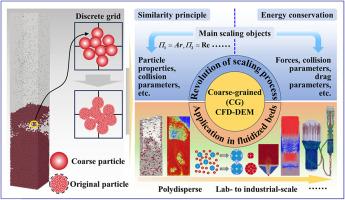粗粒度CFD-DEM技术的革命及其在流化床中的应用综述
IF 4.3
2区 材料科学
Q2 ENGINEERING, CHEMICAL
引用次数: 0
摘要
由于其优越的混合和传热能力,流化床被广泛应用于化工、发电等领域。长期以来,数值模拟一直是阐明反应器内非线性多相转移过程的必要手段。然而,随着研究视角从实验室扩展到中试和工业规模,颗粒数的指数增长限制了离散元法(DEM)、直接数值模拟等多相流模型的适用性。作为传统DEM方法的扩展,粗粒度DEM策略有效地平衡了计算效率和精度。为了促进CG DEM在流化床领域的发展,本文对其发展和应用进行了全面的综述。首先,概述了CG方法的基本原理——相似度和能量节约。碰撞参数的标度范式,力公式,和气固性质系统地按时间顺序列出。随后,总结了CG方法在实验室、中试和工业规模流化床在冷、热条件下的应用。最后,强调了未来的挑战和机遇。本综述旨在加速CG技术在工业规模反应器中的应用,同时为优化现有模型和开发新的标度定律提供理论见解。本文章由计算机程序翻译,如有差异,请以英文原文为准。

Revolution of coarse-grained CFD-DEM technology and its application in fluidized beds: A comprehensive review
Due to their superior mixing and heat transfer capabilities, fluidized beds are extensively utilized in chemical engineering, power generation, etc. Numerical simulations have long been essential for elucidating the nonlinear multiphase transfer processes within reactors. However, as the research perspective expands from lab-to pilot- and industrial-scale, the exponential increase in particle numbers constrains the applicability of multiphase flow models such as discrete element method (DEM), direct numerical simulation, etc. As an extension of traditional DEM methods, the coarse-grained (CG) DEM strategy effectively balances computational efficiency and accuracy. In order to promote the advancement of CG DEM in the field of fluidized beds, its development and applications are comprehensively reviewed in this work. First, the foundational principles of the CG method—similarity and energy conservation—are outlined. The scaling paradigms of the collision parameters, force formulations, and gas-solid properties are systematically listed in chronological order. Subsequently, the applications of the CG method across lab-, pilot-, and industrial-scale fluidized beds under both cold and heated conditions are summarized. Finally, future challenges and opportunities are highlighted. This review aims to accelerate the adoption of CG techniques in industrial-scale reactors while providing theoretical insights for optimizing existing models and developing novel scaling laws.
求助全文
通过发布文献求助,成功后即可免费获取论文全文。
去求助
来源期刊

Particuology
工程技术-材料科学:综合
CiteScore
6.70
自引率
2.90%
发文量
1730
审稿时长
32 days
期刊介绍:
The word ‘particuology’ was coined to parallel the discipline for the science and technology of particles.
Particuology is an interdisciplinary journal that publishes frontier research articles and critical reviews on the discovery, formulation and engineering of particulate materials, processes and systems. It especially welcomes contributions utilising advanced theoretical, modelling and measurement methods to enable the discovery and creation of new particulate materials, and the manufacturing of functional particulate-based products, such as sensors.
Papers are handled by Thematic Editors who oversee contributions from specific subject fields. These fields are classified into: Particle Synthesis and Modification; Particle Characterization and Measurement; Granular Systems and Bulk Solids Technology; Fluidization and Particle-Fluid Systems; Aerosols; and Applications of Particle Technology.
Key topics concerning the creation and processing of particulates include:
-Modelling and simulation of particle formation, collective behaviour of particles and systems for particle production over a broad spectrum of length scales
-Mining of experimental data for particle synthesis and surface properties to facilitate the creation of new materials and processes
-Particle design and preparation including controlled response and sensing functionalities in formation, delivery systems and biological systems, etc.
-Experimental and computational methods for visualization and analysis of particulate system.
These topics are broadly relevant to the production of materials, pharmaceuticals and food, and to the conversion of energy resources to fuels and protection of the environment.
 求助内容:
求助内容: 应助结果提醒方式:
应助结果提醒方式:


